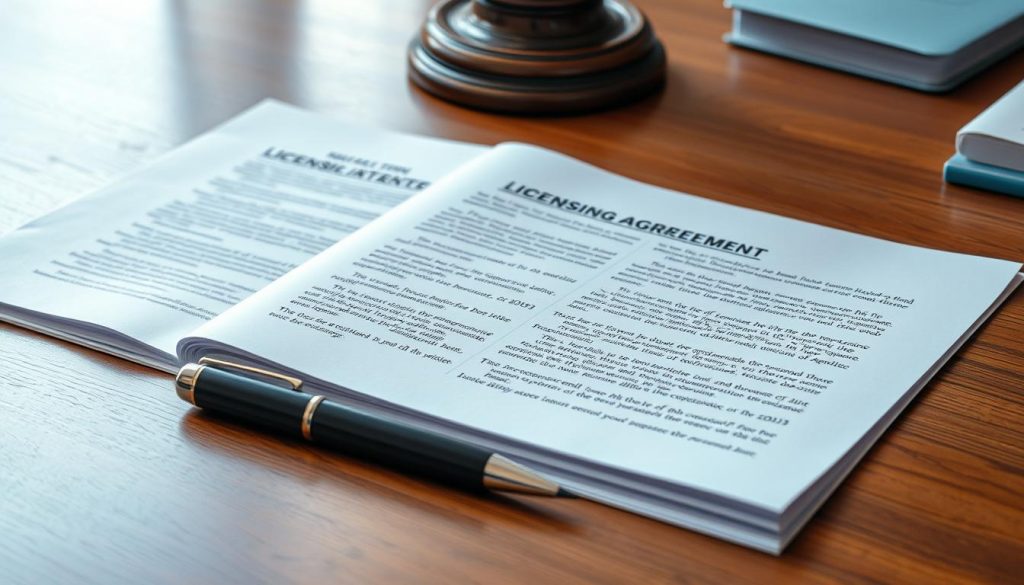Are you maximizing your earnings as a creator? Many artists and authors miss out on significant income because they don’t fully understand how royalty payments work. Whether you’re a musician, writer, or inventor, knowing your rights and leveraging licensing agreements can transform your financial future.
Royalties are payments made to creators when their work is used or licensed. These agreements ensure that you, as the owner of intellectual property, receive a fair share of the revenue generated from your work. For instance, musicians earn royalties when their songs are streamed, while authors receive payments for book sales1.
Understanding the terms of your agreements is crucial. Factors like demand, exclusivity, and innovation often determine royalty rates. By staying informed and proactive, you can ensure you’re compensated fairly for your creativity2.
Key Takeaways
- Royalties are payments for the use of creative assets like music, books, and patents.
- Licensing agreements ensure creators are compensated when their work is used.
- Royalty rates depend on factors like demand and exclusivity.
- Performance Rights Organizations (PROs) help track and distribute royalties.
- Understanding your rights and agreements is key to maximizing income.
What is a Royalty?
Understanding the concept of royalties is essential for creators aiming to protect their income. A royalty is a payment made to the owner of an asset for its ongoing use. This concept applies across industries, ensuring creators are compensated fairly for their intellectual property3.
Licensing agreements play a key role in defining the terms of these payments. These contracts outline how an asset can be used, the duration of use, and the percentage of revenue shared with the owner4. For example, songwriters receive royalties when their music is streamed, while authors earn payments based on book sales.
Definition and Overview
At its core, a royalty is a financial arrangement that benefits both the asset owner and the user. The owner receives a percentage of the revenue generated, while the user gains access to valuable resources. This system is widely used in industries like music, publishing, and franchising.
Key Examples Across Industries
In the music industry, songwriters and publishers earn royalties based on song length and usage. For instance, songs under five minutes generate $0.124 per minute, while longer tracks earn $0.239 per minute3. Authors, on the other hand, typically receive 15% of net sales for hardback books and 7.5% for paperbacks.
Franchisees also pay royalties to franchisors, often ranging from 4% to 12% of monthly gross sales4. These payments ensure the franchisor benefits from the franchisee’s success while maintaining brand standards.
Factors like demand, exclusivity, and innovation influence royalty rates. By understanding these terms, creators can negotiate agreements that maximize their income and protect their rights.
Royalties: Types and Applications
Navigating the world of royalty payments can unlock new income streams for creators. These payments vary widely across industries, from creative works to natural resources. Understanding the differences can help you maximize your earnings and protect your rights.

Book, Music, and Patent Royalties
In the publishing industry, authors typically earn 8% to 15% of net sales for their books5. For musicians, mechanical royalties range from 6% to 10% of revenue from sales or downloads5. Patent holders, especially in pharmaceuticals, often receive 2% to 10% of revenue generated by their inventions5.
Each type of royalty has unique terms. For example, music streaming pays artists $0.004 to $0.0084 per stream in well-regulated markets5. These rates highlight the importance of understanding your agreements.
Franchise and Mineral Royalties
Franchisees typically pay 6% of gross sales as royalties6. For instance, a franchise generating $1 million annually would pay $60,0006. In the mining industry, royalty payments can represent up to 10% of gross revenue from mineral extraction6.
These examples show how royalty rates vary based on the asset and industry. Whether you’re an artist or a business owner, knowing these details can help you negotiate better terms.
To further enhance your financial strategy, consider exploring diverse investment opportunities. This can help you diversify your income and secure long-term financial independence.
Licensing Agreements: Terms and Conditions
Licensing agreements are the backbone of fair compensation for intellectual property use. These contracts define how assets like music, books, or patents can be used, ensuring creators receive their due share of revenue7. Whether you’re an artist, author, or business owner, understanding these terms is crucial for protecting your rights and maximizing income.

Understanding Contract Provisions
Every licensing agreement includes specific provisions that outline the scope of use. These often cover duration, territory, and restrictions. For example, a music licensing agreement might specify that a song can only be used in a particular region for a set period8. Such terms ensure clarity and prevent disputes.
Other key provisions include payment terms, such as fixed fees or percentages of revenue. These payments, often called royalties, are calculated based on sales or usage7. Additionally, agreements may include clauses for updates, maintenance, or support, especially in technology licensing8.
Balancing Benefits for Licensor and Licensee
Licensing agreements are designed to benefit both parties. The licensor gains additional revenue and market exposure, while the licensee accesses valuable resources without heavy upfront costs9. For instance, a franchisee benefits from a well-known brand, while the franchisor earns a percentage of sales8.
However, risks exist. The licensor may lose some control over their brand, while the licensee might face challenges like subpar performance or additional marketing costs8. Clear, balanced provisions help mitigate these risks and protect both parties’ interests.
| Provision | Description | Example |
|---|---|---|
| Duration | Specifies the time period the license is valid. | 5 years for a music license7. |
| Territory | Defines the geographic area where the license applies. | North America for a book license8. |
| Payment Terms | Outlines how and when payments are made. | 10% of net sales for a patent license9. |
| Restrictions | Limits how the asset can be used. | No modifications to the software8. |
Negotiating these terms is essential for a fair agreement. Both parties should focus on their goals and potential risks. For example, a licensor might seek higher percentages for exclusive rights, while a licensee may negotiate lower fees for non-exclusive use9.
To learn more about the essential components of licensing agreements, visit our detailed guide on licensing agreements. This resource provides insights into creating contracts that protect your interests and ensure compliance.
Calculating Royalty Rates
Determining the right royalty rate is a critical step for creators to ensure fair compensation. These rates are influenced by several factors, including market innovation, exclusivity, and available alternatives. Understanding these elements can help you negotiate better terms and maximize your income.
Factors Influencing Rate Determination
Market innovation plays a significant role in setting royalty rates. For example, in the music industry, tracks under five minutes generate $0.124 per minute, while longer tracks earn $0.239 per minute10. Exclusivity also impacts rates, as exclusive rights often command higher percentages of revenue.
Available alternatives can lower rates. If multiple assets serve the same purpose, the rate may decrease. For instance, mineral mining royalties historically range from 1.0% to 3.0% based on the sales value of the exploited product10.
Calculations can differ based on gross versus net receipts. Gross receipts include total revenue, while net receipts deduct expenses. A licensor may seek a 30% share of the enterprise’s profit from a product that sells for $5, where the estimated profit on sale is $1.5010.
- Market Innovation: Drives higher rates for unique assets.
- Exclusivity: Increases rates for exclusive rights.
- Available Alternatives: Can lower rates if substitutes exist.
Arm’s length transactions ensure fair negotiations. Both parties should review all elements contributing to the final rate. For example, in book publishing, authors typically earn 8% to 15% of net sales10.
Careful consideration of these factors can lead to better agreements. By understanding the nuances of royalty rate calculations, creators can protect their rights and secure fair compensation.
Royalties in the Music Industry
The music industry offers creators multiple avenues to earn income through various copyright protections. Understanding these protections and how they translate into payments is essential for artists, songwriters, and labels alike.
Music Copyrights: Composition vs. Sound Recording
Every song has two distinct copyrights: the composition (lyrics and melody) and the sound recording (the actual recorded performance). The composition copyright protects the songwriters, while the sound recording copyright benefits the performers and record labels11.
For example, Bob Dylan, as both a songwriter and performer, earns from both copyrights. This dual protection ensures that all parties involved in creating a song are compensated fairly11.
Stakeholders and Payment Structures
Multiple stakeholders share in the revenue generated from music. Songwriters and publishers typically split publishing rights 50/50, while performers and labels share recording rights based on contractual agreements11.
Streaming platforms like Spotify pay an average of $0.003 to $0.005 per stream to songwriters, while performers earn additional payments from sound recording streams11.
| Type of Royalty | Description | Beneficiaries |
|---|---|---|
| Mechanical Royalties | Paid for the reproduction of compositions in physical or digital formats. | Songwriters, Publishers |
| Performance Royalties | Generated from public performances, including radio and streaming. | Songwriters, Publishers, PROs |
| Synchronization Royalties | Earned from licensing music for TV, films, and ads. | Songwriters, Publishers, Labels |
| Neighboring Rights Royalties | Paid for public broadcasts of sound recordings. | Performers, Labels |
Proper licensing ensures that all parties receive their due share. For instance, synchronization fees for music in advertising can range from $2,000 to $25,000, depending on the project’s scope11.
By understanding these structures, artists can better manage their income and protect their creative rights.
Maximizing Earnings: Strategies for Artists and Creators
For artists and creators, unlocking full earning potential requires more than just talent. It involves strategic planning, effective negotiation, and safeguarding your intellectual property. By mastering these elements, you can ensure fair compensation and long-term financial success.
Expert Tips for Negotiation
Negotiating higher royalty rates is a skill every creator should develop. Start by understanding the value of your work and the market demand. For example, music streaming platforms pay an average of $0.003 to $0.005 per stream to songwriters12. Use this data to justify your rates during discussions.
Always seek independent legal review of licensing agreements. This ensures the terms are fair and align with your goals. For instance, authors typically earn 8% to 15% of net sales for their books12. A well-drafted contract can protect your rights and optimize your income.
Protecting Your Intellectual Property Rights
Securing your intellectual property is crucial for maintaining control over your work. Register your creations with relevant organizations like the Harry Fox Agency (HFA) for mechanical royalties13. This step ensures accurate collection and distribution of payments.
Regularly review and update your agreements to adapt to market changes. For example, sync fees for music in advertising can range from $2,000 to $25,00012. Staying proactive helps you capitalize on new opportunities and avoid disputes.
By combining creative talent with financial savvy, you can maximize your earnings. Explore strategies for artists and creators to maximize their earnings through to diversify your income streams and achieve financial independence.
Conclusion
To thrive as a creator, mastering the nuances of income streams is essential. Royalties play a vital role in ensuring fair compensation for your work, whether you’re an author, musician, or inventor. Understanding the different types of royalty agreements and how rates are calculated can significantly boost your income.
From music streaming to book sales, each industry has unique payment structures. For example, authors typically earn 8% to 15% of net sales for their books14. Negotiating better terms and protecting your intellectual property rights are key to maximizing earnings.
We encourage you to review your current agreements and explore additional resources to refine your strategies. By staying informed and proactive, you can secure the compensation you deserve for your creative contributions.
FAQ
What is a royalty?
How are royalties calculated?
What are the types of royalties?
What is a licensing agreement?
How do music royalties work?
What strategies can artists use to maximize earnings?
Why are royalties important for creators?
Source Links
- Music royalties: how to maximise your earnings as a musician – https://pirate.com/en/blog/music-royalties/
- Music Royalties: Protecting Artists’ Earnings | Vampr – https://www.vampr.me/faq/music-royalties-explained-protecting-artists-earnings/
- What Is a Royalty? – https://www.investopedia.com/terms/r/royalty.asp
- Royalty Payments: A Comprehensive Guide – https://tipalti.com/blog/royalty-payments/
- What Is a Royalty: Its Payment Process and Types – https://www.acquire.fi/glossary/what-is-a-royalty-how-payments-work-and-types-of-royalties
- What is a Royalty: Definition, Types & Payments – Pheasant Energy – https://www.pheasantenergy.com/royalty/
- Licensing Agreement: Definition, Example, Types, and Benefits – https://www.investopedia.com/terms/l/licensing-agreement.asp
- Licensing Agreements: What Your Business Needs to Know – https://www.dhweberman.com/post/licensing-agreements-what-your-business-needs-to-know-4bc06
- 10 Key Intellectual Property (IP) Licensing Agreement Terms – What Terms Do You Need in Your Licensing Agreement? – https://www.sanjosebusinesslawyersblog.com/10-key-intellectual-property-ip-licensing-agreement-terms-what-terms-do-you-need-in-your-licensing-agreement/
- Royalty rate assessment – https://en.wikipedia.org/wiki/Royalty_rate_assessment
- Music Royalties 101 – Intro to Music Royalties – Royalty Exchange – https://www.royaltyexchange.com/blog/music-royalties-101-intro-to-royalties
- Maximizing Music Royalty Earnings | Blog – Vampr – https://www.vampr.me/faq/understanding-maximizing-your-music-royalty-earnings/
- The Complete Guide to Maximizing Music Royalties: From Basics to Advanced Strategies – https://vocal.media/education/the-complete-guide-to-maximizing-music-royalties-from-basics-to-advanced-strategies
- What are Royalties & How do Royalty Payments Work? | Tipalti – https://tipalti.com/en-eu/mass-payments-hub/royalty-payments/




0 Comments